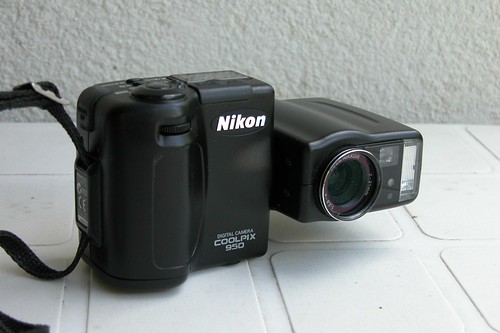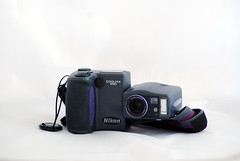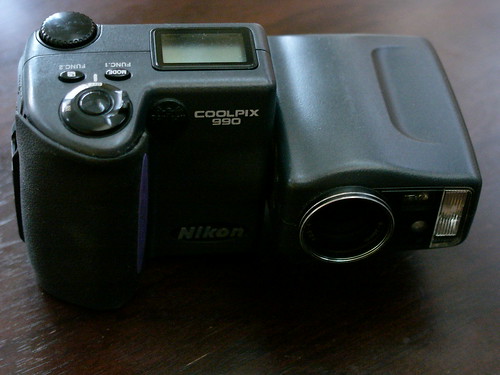Difference between revisions of "Nikon Coolpix 950"
(images added) |
(invited 2 "all rights reserved" pics to our pool, added non-commercial rights to 2 others.) |
||
| Line 1: | Line 1: | ||
| + | <!--Henry Thomas and Duc N. Ly "all rights reserved" images invited to camera-wiki pool 4/2011. Next editor, please confirm they've been added, or replace--> | ||
{{Flickr_image | {{Flickr_image | ||
|image_source= http://www.flickr.com/photos/henry63/1386002525/in/pool-camerapedia/ | |image_source= http://www.flickr.com/photos/henry63/1386002525/in/pool-camerapedia/ | ||
|image= http://farm2.static.flickr.com/1060/1386002525_f5452ef13b.jpg | |image= http://farm2.static.flickr.com/1060/1386002525_f5452ef13b.jpg | ||
|image_align= left | |image_align= left | ||
| − | |image_text= Coolpix 950 | + | |image_text= Coolpix 950 |
| + | |image_by= Henry Thomas | ||
| + | |image_rights= | ||
}} | }} | ||
The '''Nikon Coolpix 950''' and '''Nikon Coolpix 990''' are digital cameras whose bodies are in two parts so that the [[LCD]] viewing screen may swivel with respect to the lens and conventional viewfinder. They were introduced by the [[Nikon|Nikon Corporation]] in 1999/2000. They can be used for [[point-and-shoot]], but have manual overrides for most settings. One part of the body houses the controls, batteries, viewing screen, a small secondary LCD screen on top for settings display, the memory card and the tripod bush. The other part carries the lens, image sensor, focus sensor, flash and optical viewfinder. The body shell is alloy castings. | The '''Nikon Coolpix 950''' and '''Nikon Coolpix 990''' are digital cameras whose bodies are in two parts so that the [[LCD]] viewing screen may swivel with respect to the lens and conventional viewfinder. They were introduced by the [[Nikon|Nikon Corporation]] in 1999/2000. They can be used for [[point-and-shoot]], but have manual overrides for most settings. One part of the body houses the controls, batteries, viewing screen, a small secondary LCD screen on top for settings display, the memory card and the tripod bush. The other part carries the lens, image sensor, focus sensor, flash and optical viewfinder. The body shell is alloy castings. | ||
| Line 11: | Line 14: | ||
|image= http://farm5.static.flickr.com/4019/4265128392_086bcdb96e_m.jpg | |image= http://farm5.static.flickr.com/4019/4265128392_086bcdb96e_m.jpg | ||
|image_align= right | |image_align= right | ||
| − | |image_text= Coolpix 990 | + | |image_text= Coolpix 990 |
| − | }}{{Flickr_image | + | Image_by= Missy Bergen |
| + | |image_rights=non-commercial | ||
| + | }} | ||
| + | {{Flickr_image | ||
|image_source= http://www.flickr.com/photos/cocktail_hour/4264375955/in/pool-camerapedia/ | |image_source= http://www.flickr.com/photos/cocktail_hour/4264375955/in/pool-camerapedia/ | ||
|image= http://farm5.static.flickr.com/4034/4264375955_882bd56c53_m.jpg | |image= http://farm5.static.flickr.com/4034/4264375955_882bd56c53_m.jpg | ||
|image_align= right | |image_align= right | ||
| − | |image_text= Coolpix 990 (flat) | + | |image_text= Coolpix 990 (flat) |
| + | Image_by= Missy Bergen | ||
| + | |image_rights=non-commercial | ||
}} | }} | ||
| Line 26: | Line 34: | ||
|image= http://farm4.static.flickr.com/3197/2905656678_c1e3596b45.jpg | |image= http://farm4.static.flickr.com/3197/2905656678_c1e3596b45.jpg | ||
|image_align= right | |image_align= right | ||
| − | |image_text= Coolpix 990 | + | |image_text= Coolpix 990 |
| + | |image_by= Duc N. Ly | ||
| + | image_rights= | ||
}} | }} | ||
Technically these are excellent cameras. Both have internal-focus, internal-zoom lenses, and close-focus to less than 1 inch. Nikon lens quality was very closely watched at this stage of their digital evolution, as they stated that they would not allow their reputation to fall by outsourcing or producing inferior-quality optics. | Technically these are excellent cameras. Both have internal-focus, internal-zoom lenses, and close-focus to less than 1 inch. Nikon lens quality was very closely watched at this stage of their digital evolution, as they stated that they would not allow their reputation to fall by outsourcing or producing inferior-quality optics. | ||
Revision as of 22:05, 7 April 2011

|
| Coolpix 950 image by Henry Thomas |
The Nikon Coolpix 950 and Nikon Coolpix 990 are digital cameras whose bodies are in two parts so that the LCD viewing screen may swivel with respect to the lens and conventional viewfinder. They were introduced by the Nikon Corporation in 1999/2000. They can be used for point-and-shoot, but have manual overrides for most settings. One part of the body houses the controls, batteries, viewing screen, a small secondary LCD screen on top for settings display, the memory card and the tripod bush. The other part carries the lens, image sensor, focus sensor, flash and optical viewfinder. The body shell is alloy castings.

|
| Coolpix 990
Image_by= Missy Bergen (Image rights) |

|
| Coolpix 990 (flat)
Image_by= Missy Bergen (Image rights) |
The shutter-release button is surrounded by the off/Auto/M/play switch; in front of this on the 950 is a finger-wheel for manual adjustments; this wheel moves to the top back edge on the 990. On the back, behind the shutter-release are two buttons for zooming in and out, falling under the thumb. Above the screen are buttons for turning the monitor screen on/off, and a menu button; below the screen are buttons labelled delete/+/-, Mode and Qual.
The 950 has a rubbery cover on the top-front, underneath which are the video and power connectors. The 990 has the power connector on the front - again under a rubbery cover, and the video & USB connectors on the end.

|
| Coolpix 990 image by [[:Category:image by Duc N. Ly image_rights=|Duc N. Ly image_rights=]] |
[[Category:Image by Duc N. Ly image_rights=]] Technically these are excellent cameras. Both have internal-focus, internal-zoom lenses, and close-focus to less than 1 inch. Nikon lens quality was very closely watched at this stage of their digital evolution, as they stated that they would not allow their reputation to fall by outsourcing or producing inferior-quality optics. One of the really advanced features for the time was shutter speeds and aperture values which were virtually continuously-variable. It would be normal for the camera to expose an image at a value such as f/3.1 for 1/643 of a second. Here you can again see the Nikon devotion to the quality of the image.
I believe that the CCD in these cameras were four-colour CMYK. The rear LCD was of the glossy (rather than anti-glare) type and were much better for accurately viewing images. Filter ring is 28mm, polarizers were available. Accessory lenses mount on the filter threads, and not only are of very high optical quality, do not reduce the amount of light entering the camera. Of particular note, the Nikon 3x add-on lens is of ED glass quality.
One really unique quality of this body style, as opposed to the flip-out screen style, is stability when you use the camera at waist level like a 2-1/4" twin lens reflex. The lens faces outwards, the LCD upwards, press the camera to your body and shoot longer exposures. The logic --- with other cameras shooting from eye-level means that your slightest body movement is accentuated by the distance from your feet to your eyes. If you are using the LCD as your viewfinder, even more so.
Unlike the successor 995, these two bodies do not have a pop-up flash, instead employing the compact style of locating it right beside the lens. Power is supplied by 4 AA batteries. Tripod socket is on the body, not centered on the lens or the CCD plane. Nikon has a flash bracket specifically designed for this body style. Note that the finger-grip rubber insert on the front panel was distinctly coloured for the market that the camera was intended for.
Specifications
| 990 | 950 | |
| Announced: | 27th January 2000 | 1999 |
| Lens: | Zoom-Nikkor, 8-24mm, f2.5-4 38-115mm equivalent |
Zoom-Nikkor, 38-115mm equivalent |
| Storage: | CompactFlash cards | CompactFlash cards |
| Resolution: | 3.1 megapixels (2048 x 1536) | 2 megapixels (1600 x 1200) |
| ISO settings | 80, 100, 160, 320 | 80, 100, 200, 400 |
External links
- Removing the IR Blocking Filter in the Nikon 950 and 990, subtitled "or How to Ruin Your New Camera"